|

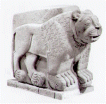
|
|
 Since the Byzantine era, Italians
have demonstrated a great deal of interest towards Anatolia. This interest has
increased with the arrival of the Turks in Anatolia. Consequently, in an era of wars in the Mediterranean,
excellent relations have been established with the then separate city-states
of Pisa, Genoa and Venice. Since the Byzantine era, Italians
have demonstrated a great deal of interest towards Anatolia. This interest has
increased with the arrival of the Turks in Anatolia. Consequently, in an era of wars in the Mediterranean,
excellent relations have been established with the then separate city-states
of Pisa, Genoa and Venice.
The relations have been further
strengthened during the Ottoman Empire. While the peoples of the Mediterranean
were at war with each other at that time, Italian and Turkish peoples have
maintained their cultural and commercial relations. Relations with Venice, which has become preeminent among the
states in the Apennine peninsula, were established as soon as in 1381. The
content of the relations have been expanded when Venetians and Genovese rented
their ships to the Ottomans for their expedition to Europe. All oriental
merchants were able to reach Europe due to the tolerant attitude and policies
of the Ottoman Empire. While marvelous carpets embellished the palaces of
Florence, Italian bankers carried out activities in Anatolia.
During the reign of Sultan Mehmet
II (the Conqueror), who was an admirer of Italian culture, relations reached
their climax. The signing of a Reciprocal Extradition Agreement between
the Ottoman Empire and Florence illustrates this trend. In fact, a citizen of
Florence who killed Lorenzo de Medici and escaped to Istanbul was extradited
to Florence because of this agreement. Sultan
Mehmet II the Conqueror invited painter Bellini to his court and became the
first Sultan to have his portrait painted.
During the reign of Sultan Mehmet
II, the Ottoman Empire entered in its period of rise and expansion. Between 15
and 18 centuries, the Ottoman Empire and Venice, as representatives of East/Muslim
and West/Christian worlds respectively, were protagonists in the world
historical stage. During that period, their relations were characterized by
times of conflict and cooperation, depending on the changing interests of the
parties. Both states struggled to obtain the control of the Mediterranean.
Turks first landed in the Italian
peninsula in 1480 and seized the Otranto Castle, belonging to the Kingdom of
Naples. The unexpected death of Sultan Mehmet II gave way to the power
struggle between his two sons, Beyazıt and Cem and Beyazıt recalled Gedik
Ahmet Paşa, commander of the Ottoman forces in Otranto.
|
Ascent to the throne of Beyazıt II led Cem Sultan to
take refuge with the Knights of Rhodes, and then to Vatican and France. His
journey that ended with his death in Naples has been an unfortunate event both
for himself and for the Ottoman Empire.
|

SantAngelo Castle
(Castel SantAngelo)
|
Cem Sultan, who was considered as
a bargaining chip at the hands of European Christianity, spent the last
period of his captivity at Sant Angelo Castle, located at the banks of
river Tiber.
Turkish Italian relations
have maintained the same course during the reigns of Kanuni Sultan Süleyman
(Süleyman the Magnificent) and Mahmut II. In this period, there were good
political, judicial, commercial and cultural relations between the Ottoman
Empire and Venice. Similarly, it is known that Andrea Gritti, who was the
Dodge of Venice in the 16. century established cordial relationship with Süleyman
the Magnificent and the Ottoman Court. It is worth noting that Barbaro,
the Emissary of Venice has continued to reside in Istanbul despite the
Lepanto War (1571) waged between the Ottoman Fleet and the Crusade Fleet
under the leadership of Venice.
Ottoman Empire has overall kept
its doors open to Italians and Europeans. Emissaries of Venice were able
to move freely. Churches that testimony the establishment in the
territories of the Ottoman Empire of Emissaries of the Holy See and
Italian priests in general, are a symbol of tolerance in Turkey. It is
also known that prisoners of war from both sides did not remain as such
and could settle down in the territories where they were taken.
Juridical authority over Venetian
citizens living within the borders of the Ottoman Empire was accorded to
the Emissary of Venice, who stayed permanently in Istanbul, in accordance
with the agreement of 1479. Venetian Emissaries, dubbed as Balyos at
that time, contributed a great deal to the pleasurable social life of Beyoğlu
(Pera) with their grand palace in Taksim (Palace of Venice). In 1524, the
Venetian Emissary held for the first time an exhibition of ballet for the
Italians living in Istanbul.
During the reign of Mahmut II
numerous Italians from different backgrounds such as officers, musicians, doctors, found a
second homeland in the Ottoman Empire. Giuseppe Donizetti (brother of the
famous opera compositor Gaetano Donizetti), who was invited by Mahmut II
in 1827 as the conductor of the Orchestra of the Empire (Muzıka-ı Humayün)
and the Italian musicians that came along are vivid examples of this
trend. Donizetti conducted the orchestra for 28 years until his death and
laid the foundations of the current Istanbul Symphony Orchestra. Donizetti
was awarded with the title of Pasha by the Sultan and was replaced
afterwards by the Italian conductors Angelo Mariani, Pisani and Callisto
Guatelli (Pasha).
Italian operas and especially
those of Verdi were frequently staged in Istanbul theaters. The French
theater in Galatasaray, the first opera and theater building at which the
first operetta and musical was staged, was built in 1839 by a Venetian
named Giustiniani. Another Italian named Bosco established a second
theater in Pera in 1841-1842 and the opera Belisario by Donizetti
was the first opera to be staged in the Ottoman Empire. Another opera
Lucrezia Borgia (named after the daughter of Alexander Borgia, who
has kept Cem Sultan under his custody) was staged in 1844.
Numerous Italian painters and
architects have also produced works in Istanbul. Chief among them is
Raimondo DAronco, architect of Sheikh Zafir Compound. DAronco who
came to Istanbul in 1896, was assigned by the Sultan with the restoration
works of the monuments of the city. These works still cause the admiration
of many tourists nowadays. Giulio Mongeri, Guglielmo Semprini, Gaspere
Fossati, Vitaliano Poselli, Piero Arigoni have also been among the
architects/engineers of buildings in Istanbul and İzmir, whereas in the
Republican era sculptor Pietro Canonica was famous for his sculptures of
Atatürk.
Fausto Zonaro has been cited
along with Bellini as Italian painters in Istanbul. Sultan Abdülhamid II
assigned Zonaro as the painter of the court. Zonaro came to Istanbul in
1891 and returned to San Remo in 1911 due to the breakout of the Turkish
Italian War. Zonaro has painted the embellishments decorating the
Turkish Poems, written by Mehmet Emin Yurdakul and published in
1899. Another Italian painter Leonardo de Mango went to Istanbul when the
School of Fine Arts was established in 1883 serving there as a
scholar until his death in 1927.
We can also find in the Turkish
novels and tales the characters representing Italian painters or merchants
just as the real Italian painters that lived in the Ottoman Turkish
society cited above and whose examples can be multiplied. Especially, in
the works of the post reformation (Tanzimat) era, Italy was associated
with fine arts and Italians with artists. The works of Abdülhak Hamit
Tarhan, Ahmet Mithat Efendi, Hüseyin Rahmi Gürpınar, Halit Ziya Uşaklıgil,
Ömer Seyfettin, Fakir Baykurt, Kemal Tahir and many others bear testimony
to this premise.
The
Italian Language was very familiar especially to the people of Istanbul
and Italian terms in the fields of marine, music, trade and banking were
introduced into daily life.
|
The traces of Turkish Italian
relations can be observed in Italy as well. There are several examples: a
restaurant in Otranto named after Gedik Ahmet Paşa (the Ottoman
Commander who had captured Otranto in 1480), the recruitment of the
soldiers of Gedik Ahmet Paşa by the King of Naples when he left Otranto
to return to Istanbul a year later, nobility signs of Pedreables,
Tommasini and Brevei families of Genoa consisting of crescent and star,
the dictionary of Codex Comanicus located at the National Library
in Venice with its Italian, Turkish and Persian versions, Letteratura
Dei Turchi, the first book on Turkish literature in Europe published
in Venice in 1688 by Gian Battista Donaldo, Rossinis opera Maometto
II whose subject matter is Sultan Mehmet II, Bonarellis tragedy
Solimano (Süleyman the Magnificent), the painting on the wall of
the church at San Marco Square in Venice depicting the trade between
Ottoman and Venetian merchants, Fondaco Dei Turchi located on the
Grande Canale in Venice, also known as the Turkish Inn, which was
inaugurated in 1621 and allocated to Turkish merchants for the ensuing
200 years, the building in Ferra owned by a family whose members served
the Ottoman Empire bearing an inscription on it as Seraglio Turco (Turkish
Palace), the annual festivities held in Moena, a town near the Austrian
border, in memory of the Janissary who took refuge there after the II.
siege of Vienna in 1683, the designation of a street in the same town as
Turchia, a sculpture of a Turkish soldier carved out of a tree and
another sculpture of a Janissary with crescent and star, all reflect the
dimension of bilateral relations. (Note: The pictures concerning Moena
has been provided by the Municipality of Moena and from the internet site
of the Municipality of Moena. Availing this opportunity the Embassy of
the Republic of Turkey in Rome thanks to the Municipality of Moena).
The
intensity of bilateral relations has influenced also the Italian popular
culture and some idiomatic expressions referring to the Turks are
commonly used in daily life. The most used among these expressions are
the following:
To smoke like a Turk (Fumare
come un Turco)
Strong like a Turk (Forte
come un Turco)
Mommy, the Turks are coming
(Mamma li Turchi)
To swear like a Turk (Bestemmiare
come un Turco)
|

The
Turkish inn
(Fondaco dei Turchi)
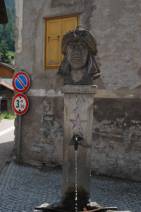
The
sculpture of a Turkish soldier
in Moena

The
Turkish street in Moena
(Via Turchia)
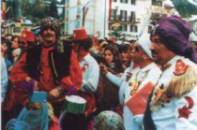
The
celebration in Moena
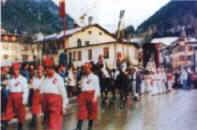
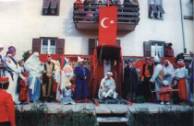
|
The relations, that continued to
develop after the unification of Italy, deteriorated when Italy attacked
Tripoli in 1911. The lack of intervention by the Ottoman Empire already
engaged in the Balkans War left Tripoli and the Twelve Islands under
Italian rule.
Italy, which was among the
foreign powers that invaded Anatolia following the First World War,
relinquished the places it held in Anatolia in June 1921.
Thus, Italy became the first
country among the powers that intended to share the Anatolian territory
after the First World War, to establish friendly relations with Turkey.
Thanks to the establishment of
friendly relations between Turkey and Italy at the end of the Liberation
War under the leadership of Atatürk, the two peoples began to know each
other better and remember their numerous resemblances more than their
differences.
The presence in Rome of a
representative of the Turkish Government in addition to the Ottoman
Embassy during the Liberation War, contributed greatly to the start of
future friendly relations.
The crew of an Italian vessel
anchored in the harbor followed the funeral ceremony of Atatürk when he
died on 10 November 1938 in Istanbul.
One of the main reforms achieved
by Atatürk was the abrogation of the Shariah Law and the adoption of
secular legislation and in this framework, the Italian Criminal Law was
chosen as a reference for the Turkish Criminal Law.
Besides the difficulties
encountered in the period between the signing of the Lausanne Treaty and
the Second World War due to the policies of Mussolini and in the last
period due to the terrorist leader Abdullah Öcalan, the relations between
Turkey and Italy have been carried out based on mutual understanding and
national interests without important problems. Hence it would not be wrong
to state that the Italian people knows to search for friendship instead of
hostility in history, just like the Turkish people.
The Italian Prime Minister Silvio
Berlusconi and his Government attach great importance to the development
of Turkish-Italian relations in every field and in this framework support
the membership to the EU of the democratic and secular Turkey with a
majority of Muslim population.
In
the last years average, Italy ranks third in the exports of Turkey and
second in its imports. Though they do not reflect the real potential, the
relations between Turkey and Italy in tourism are also in an important
level. The cultural relations are in an increasing trend thanks to the
signing of agreements and programs, the twin town projects, the reciprocal
participation to various events through the extent of individual contacts,
common organizations, exchange of students and scholarships.
|